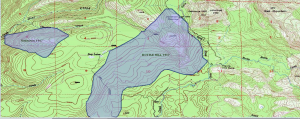Bottle Hill Fire 1917-Pacific Ranger District-Eldorado National Forest
Bottle Hill Fire October, 1917
 The majority of the eventual Gerle Creek Summer Home Tract burned in the October, 1917 Bottle Hill Fire on the Georgetown Ranger District, Eldorado National Forest. The fire consumed 3000 acres, including areas of the King Fire in 2014 and the Fork Fire of 2020. The Forest Service most probably named this fire using a local description for the 6200ft hill up behind the Gerle Creek Summer Home Tract and what is Airport Flats today. Since Jacobsens Dairy and Francis Cow Camp were both very active dairies and ranches in the teens of the 20th Century, one guess is along the Dry Lakes Trail which starts at Jacobsens and proceeds to the West just on the North edge of the peak may have had a place where the ranchers disposed of old things including bottles which was coined in the late 19th and early 20th Century to describe this peak and become the basis for the name of the fire.
The majority of the eventual Gerle Creek Summer Home Tract burned in the October, 1917 Bottle Hill Fire on the Georgetown Ranger District, Eldorado National Forest. The fire consumed 3000 acres, including areas of the King Fire in 2014 and the Fork Fire of 2020. The Forest Service most probably named this fire using a local description for the 6200ft hill up behind the Gerle Creek Summer Home Tract and what is Airport Flats today. Since Jacobsens Dairy and Francis Cow Camp were both very active dairies and ranches in the teens of the 20th Century, one guess is along the Dry Lakes Trail which starts at Jacobsens and proceeds to the West just on the North edge of the peak may have had a place where the ranchers disposed of old things including bottles which was coined in the late 19th and early 20th Century to describe this peak and become the basis for the name of the fire.
In walking some of the lots on the upper end of the summer home tract, most of the large trees all have substantial fire scars on them including an entirely burned huge cedar tree which was laying across Lot 24 covered by buck brush when the Brattland family signed their lease on that lot in 1958 and remains today. The lower tract road and most probably the middle tract road were just outside the southern perimeter of this fire, while the upper road and the rest of the tract to the North end of it were definitely inside the fire border including the area of the pump house. Looking at your oldest and largest trees especially the cedars will clearly show any burn scars from this fire if they were in it.
In Dana Supernowicz, "Historical Overview of the Eldorado National Forest," his Masters Thesis in 1985, page 174 he discusses the lessons learned on the forest from the fires on this forest during 1917, including the Bottle Hill Fire. The records of this fire are in the historical archives of the Eldorado National Forest offices in Placerville.
Many thanks to Gene Rogers, retired US Forest Service Fire Analyst for finding the above historical map for me. I had personally read the fire records from the "teens" of the 20th Century in the EDNF archives in the early 1990s but had never seen the graphic presentation which is now apart of the fire history on our forest. A brief note in the "Engineering and Mining Journal, Volume 104, 1917" reported on the Bottle Hill Fire on Georgetown Ranger District indicating it was under control and had consumed 3000 acres.
The Bottle Hill Fire of 1917 was a devastating wildfire that occurred in the Eldorado National Forest in California, United States. The fire started on August 25, 1917, and burned for several weeks, consuming over 80,000 acres of forestland.
The cause of the fire was believed to be a lightning strike, and it quickly spread due to dry weather conditions and strong winds. The fire was first spotted near Bottle Hill, a prominent landmark in the region, and it quickly spread to neighboring areas.
At the time, firefighting techniques were not as advanced as they are today, and firefighters had limited resources to combat the flames. Despite the efforts of over 2,000 firefighters, the fire raged on for weeks, destroying much of the forest in its path.
In addition to the loss of forestland, the fire also claimed the lives of several firefighters and civilians. The exact number of casualties is unknown, but estimates range from 20 to 40 people.
The Bottle Hill Fire of 1917 was one of the most devastating wildfires in California's history, and it played a significant role in shaping the state's approach to wildfire management and prevention. Today, the Eldorado National Forest has a robust fire management program in place, which includes measures such as prescribed burns, fuel reduction, and early detection and response systems to prevent future catastrophic wildfires.
